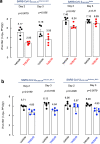Identification of SARS-CoV-2 Mpro inhibitors containing P1' 4-fluorobenzothiazole moiety highly active against SARS-CoV-2
- PMID: 36841831
- PMCID: PMC9958325
- DOI: 10.1038/s41467-023-36729-0
Identification of SARS-CoV-2 Mpro inhibitors containing P1' 4-fluorobenzothiazole moiety highly active against SARS-CoV-2
Abstract
COVID-19 caused by SARS-CoV-2 has continually been serious threat to public health worldwide. While a few anti-SARS-CoV-2 therapeutics are currently available, their antiviral potency is not sufficient. Here, we identify two orally available 4-fluoro-benzothiazole-containing small molecules, TKB245 and TKB248, which specifically inhibit the enzymatic activity of main protease (Mpro) of SARS-CoV-2 and significantly more potently block the infectivity and replication of various SARS-CoV-2 strains than nirmatrelvir, molnupiravir, and ensitrelvir in cell-based assays employing various target cells. Both compounds also block the replication of Delta and Omicron variants in human-ACE2-knocked-in mice. Native mass spectrometric analysis reveals that both compounds bind to dimer Mpro, apparently promoting Mpro dimerization. X-ray crystallographic analysis shows that both compounds bind to Mpro's active-site cavity, forming a covalent bond with the catalytic amino acid Cys-145 with the 4-fluorine of the benzothiazole moiety pointed to solvent. The data suggest that TKB245 and TKB248 might serve as potential therapeutics for COVID-19 and shed light upon further optimization to develop more potent and safer anti-SARS-CoV-2 therapeutics.
© 2023. This is a U.S. Government work and not under copyright protection in the US; foreign copyright protection may apply.
Conflict of interest statement
The authors declare no competing interests.
Figures




Similar articles
-
Exploratory Studies of Effective Inhibitors against the SARS-CoV-2 Main Protease by Halogen Incorporation and Amide Bond Replacement.Chem Pharm Bull (Tokyo). 2023;71(12):879-886. doi: 10.1248/cpb.c23-00562. Chem Pharm Bull (Tokyo). 2023. PMID: 38044140
-
Structural and virologic mechanism of the emergence of resistance to Mpro inhibitors in SARS-CoV-2.Proc Natl Acad Sci U S A. 2024 Sep 10;121(37):e2404175121. doi: 10.1073/pnas.2404175121. Epub 2024 Sep 5. Proc Natl Acad Sci U S A. 2024. PMID: 39236245 Free PMC article.
-
Biological characterization of AB-343, a novel and potent SARS-CoV-2 Mpro inhibitor with pan-coronavirus activity.Antiviral Res. 2024 Dec;232:106038. doi: 10.1016/j.antiviral.2024.106038. Epub 2024 Nov 20. Antiviral Res. 2024. PMID: 39577571
-
SARS-CoV-2 Mpro: A Potential Target for Peptidomimetics and Small-Molecule Inhibitors.Biomolecules. 2021 Apr 19;11(4):607. doi: 10.3390/biom11040607. Biomolecules. 2021. PMID: 33921886 Free PMC article. Review.
-
Targeting the Dimerization of the Main Protease of Coronaviruses: A Potential Broad-Spectrum Therapeutic Strategy.ACS Comb Sci. 2020 Jun 8;22(6):297-305. doi: 10.1021/acscombsci.0c00058. Epub 2020 May 27. ACS Comb Sci. 2020. PMID: 32402186 Review.
Cited by
-
Recent Advances in SARS-CoV-2 Main Protease Inhibitors: From Nirmatrelvir to Future Perspectives.Biomolecules. 2023 Sep 2;13(9):1339. doi: 10.3390/biom13091339. Biomolecules. 2023. PMID: 37759739 Free PMC article. Review.
-
On the origins of SARS-CoV-2 main protease inhibitors.RSC Med Chem. 2023 Oct 13;15(1):81-118. doi: 10.1039/d3md00493g. eCollection 2024 Jan 25. RSC Med Chem. 2023. PMID: 38283212 Free PMC article. Review.
-
Thioamides in medicinal chemistry and as small molecule therapeutic agents.Eur J Med Chem. 2024 Nov 5;277:116732. doi: 10.1016/j.ejmech.2024.116732. Epub 2024 Aug 5. Eur J Med Chem. 2024. PMID: 39106658 Free PMC article. Review.
-
An orally available P1'-5-fluorinated Mpro inhibitor blocks SARS-CoV-2 replication without booster and exhibits high genetic barrier.PNAS Nexus. 2025 Jan 7;4(1):pgae578. doi: 10.1093/pnasnexus/pgae578. eCollection 2025 Jan. PNAS Nexus. 2025. PMID: 39831159 Free PMC article.
-
Contrasting mechanistic susceptibilities of hematopoietic and endothelial stem-progenitor cells in respective pathogeneses of HIV-1 and SARS-CoV-2 infections.Front Cell Dev Biol. 2023 Dec 6;11:1296986. doi: 10.3389/fcell.2023.1296986. eCollection 2023. Front Cell Dev Biol. 2023. PMID: 38155835 Free PMC article.
References
Publication types
MeSH terms
Substances
Supplementary concepts
LinkOut - more resources
Full Text Sources
Medical
Molecular Biology Databases
Miscellaneous

